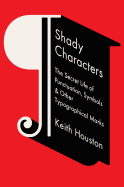
Keith Houston's Shady Characters is an entertaining history of things nearly everyone uses daily, but few of us think about. Why, for example, are paragraphs often indented? Why is the @ symbol used in e-mail addresses? Why does # have so many different names (including hashtag, pound sign and octothorpe)? When did quotation marks first appear in written history?
Houston answers these and other questions, devoting a chapter each to the history of various punctuation and typographical marks: such as the pilcrow (¶), the asterisk (*) and the dash (-). He traces their origins from ancient Greek and Latin, through the monks and scholars of the Middle Ages, the standardization of Gutenberg's printing press and the limitation of the typewriter's keyboard size--which affected the characters that would survive into modern usage.
Shady Characters is full of delightful trivia--like the fact that the ampersand (&) started life as Pompeiian graffiti, or that pound is abbreviated lb. because it derives from the Latin expression libra pondo (a pound in weight), or that the name of the interrobang, which combines the question mark and exclamation point in a single symbol, came out of a magazine contest in the 1960s. Full of illustrations ranging from images of ancient manuscripts to typewriter keyboards and contemporary typefaces, Shady Characters is an engaging mix of grammar and typography that fans of etymology, history and graphic design can all enjoy. --Jessica Howard, blogger at Quirky Bookworm

